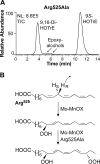Crystal Structure of Manganese Lipoxygenase of the Rice Blast Fungus Magnaporthe oryzae
- PMID: 26783260
- PMCID: PMC4825015
- DOI: 10.1074/jbc.M115.707380
Crystal Structure of Manganese Lipoxygenase of the Rice Blast Fungus Magnaporthe oryzae
Abstract
Lipoxygenases (LOX) are non-heme metal enzymes, which oxidize polyunsaturated fatty acids to hydroperoxides. All LOX belong to the same gene family, and they are widely distributed. LOX of animals, plants, and prokaryotes contain iron as the catalytic metal, whereas fungi express LOX with iron or with manganese. Little is known about metal selection by LOX and the adjustment of the redox potentials of their protein-bound catalytic metals. Thirteen three-dimensional structures of animal, plant, and prokaryotic FeLOX are available, but none of MnLOX. The MnLOX of the most important plant pathogen, the rice blast fungusMagnaporthe oryzae(Mo), was expressed inPichia pastoris.Mo-MnLOX was deglycosylated, purified to homogeneity, and subjected to crystal screening and x-ray diffraction. The structure was solved by sulfur and manganese single wavelength anomalous dispersion to a resolution of 2.0 Å. The manganese coordinating sphere is similar to iron ligands of coral 8R-LOX and soybean LOX-1 but is not overlapping. The Asn-473 is positioned on a short loop (Asn-Gln-Gly-Glu-Pro) instead of an α-helix and forms hydrogen bonds with Gln-281. Comparison with FeLOX suggests that Phe-332 and Phe-525 might contribute to the unique suprafacial hydrogen abstraction and oxygenation mechanism of Mo-MnLOX by controlling oxygen access to the pentadiene radical. Modeling suggests that Arg-525 is positioned close to Arg-182 of 8R-LOX, and both residues likely tether the carboxylate group of the substrate. An oxygen channel could not be identified. We conclude that Mo-MnLOX illustrates a partly unique variation of the structural theme of FeLOX.
Keywords: crystal structure; enzyme mechanism; fatty acid oxidation; lipoxygenase pathway; metalloenzyme.
© 2016 by The American Society for Biochemistry and Molecular Biology, Inc.
Figures








References
-
- Brash A. R. (1999) Lipoxygenases: occurrence, functions, catalysis, and acquisition of substrate. J. Biol. Chem. 274, 23679–23682 - PubMed
-
- Haeggström J. Z., and Funk C. D. (2011) Lipoxygenase and leukotriene pathways: biochemistry, biology, and roles in disease. Chem. Rev. 111, 5866–5898 - PubMed
-
- Brodhun F., and Feussner I. (2011) Oxylipins in fungi. FEBS J. 278, 1047–1063 - PubMed
-
- Heshof R., Jylhä S., Haarmann T., Jørgensen A. L., Dalsgaard T. K., and de Graaff L. H. (2014) A novel class of fungal lipoxygenases. Appl. Microbiol. Biotechnol. 98, 1261–1270 - PubMed
Publication types
MeSH terms
Substances
Associated data
- Actions
- Actions
- Actions
- Actions
- Actions
LinkOut - more resources
Full Text Sources
Other Literature Sources
Research Materials

